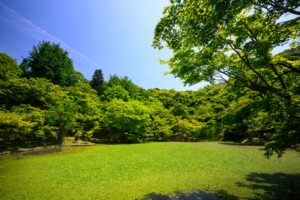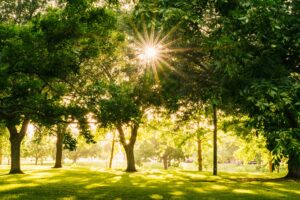Tree Service Providence Utah

Tree Service Providence Utah
Trees are the cornerstones of most outdoor spaces. They add significant functional and aesthetic value to a landscape. However, as valuable as they are, trees require regular maintenance and care to get the most out of them while also ensuring they never become a safety hazard.
Tree planting is the process of planting a new tree in a specific location. This can be done for various reasons, such as replacing a tree that has been removed, adding shade or beauty to a property, or improving the environment. Pruning is the process of removing dead, diseased, or damaged branches from a tree. This can be done for various reasons, such as to improve the tree’s overall health, remove branches that are interfering with power lines or buildings, or rove the tree’s appearance. Shaping is the process of trimming and pruning a tree to give it a specific shape. This can be done for aesthetic reasons or to improve the tree’s overall health. Cabling and bracing is the process of providing support to a tree by installing cables and/or braces. This can be done to help support a tree that is at risk of falling over, or to help support a tree that has been damaged by severe weather.
Tree removal refers to the process of cutting down and removing a tree from a specific location. This can be done for a variety of reasons, such as to clear land for development, to remove a dead or diseased tree, or to improve the overall health of a forest. The process typically involves cutting down the tree using specialized equipment and then removing the stump and debris from the area. Tree removal can be dangerous and should only be done by trained professionals.
Tree removal, also known as tree cutting, is the process of cutting down and removing a tree from a specific location. This can be done for a variety of reasons, such as to clear land for development, to remove a dead or diseased tree, or to improve the overall health of a forest.
While many homeowners may consider tree care a DIY project, the reality is that it is a project that requires expert knowledge, equipment, and experience.
This is why, to get the best tree care results, it is preferable to engage the services of a professional tree care business like Hidden Oak Tree Care.
PROVIDENCE TREE SERVICE
A tree service business offers professional, quality care for the trees on your property while ensuring all operations are done safely and effectively.
Whether you are looking for a specific tree service or comprehensive tree care, a tree service business has you covered. The extensive range of tree services include the following areas.
PROFESSIONAL ARBORIST SERVICES
Professional arborists are experts in tree and plant care. Whether it is a professional diagnosis of the disease rotting your trees and plants, or advice on how to improve the quality of soil, and facilitate the health and growth of your vegetation, professional arborists have you covered.
TREE PRUNING
Tree pruning is an essential tree service designed to improve the health and aesthetics of the tree. It involves the targeted removal of unnecessary, diseased, or damaged branches of a tree. While typically trees need pruning once every one to two years, it can vary based on circumstances. For example, flowering trees might need pruning twice a year whereas young trees you want to keep small might need pruning at least once a year.
TREE REMOVAL
As beautiful as trees are, sometimes the only solution is removing a tree. This could be because it is diseased or damaged beyond repair and serves as a safety hazard and a potential threat to the health of the other trees and plant life. Tree removal can be a complex process requiring heavy, specialist machinery when the tree being removed is a big one. While small trees are easier to remove, there is still a method and a certain amount of expertise required to getting it right with minimal collateral damage
TREE CABLING AND BRACING
Oftentimes, a tree is healthy but its structural integrity is compromised due to weather conditions, its irregular shape, or dense foliage. In such cases, tree cabling and bracing is used to provide structural support to the tree. This is the ideal solution in cases where the tree is perfectly healthy, adding significant aesthetic and functional value, but is structurally weak. Cabling and bracing enable such a tree to remain on the property while ensuring it does not become a risk to life and property around it.
STUMP GRINDING
Once a tree is removed, the stump gets left behind in the ground. This serves to be an eyesore, a tripping hazard, a breeding ground for pests, and a waste of perfectly good outdoor space. This is why getting rid of it is the best option. One method of getting rid of the stump is to use the process of stump grinding. It involves using a stump grinding machine to grind the stump down, making it level to the ground. Stump grinding is a non-invasive, efficient method of getting rid of the stump while also being environment-friendly as the ground stump can be used as mulch to improve the quality of the soil.
STROM DAMAGE AND CLEANLUP
After a storm, it is essential you inspect you property for damage. This includes inspecting the trees to ensure there isn’t any damage that threatens life or property. A professional Providence tree service business will help assess the damage and rectify it immediately. This includes dealing with fallen, broken branches, weakened trees, and the like.
You want to put your Providence tree service projects in good hands. Here’s why choosing Hidden Oak Tree Care professionals for the job is a good idea:
Expertise and Experience: A tree care business has the expert tree professionals for the job. They know all there is to know about trees and how best to deal with them. Additionally, arborists can provide expert advice on how to improve the health and look of your outdoor space, while also helping solve any tree health concerns.
Equipment and Professional Operation: Several tree services, such as tree removal and stump grinding, require professional-grade equipment that is not commonly owned by households. Additionally, tree service businesses don’t just have the right equipment for the job but they also have the knowledge and experience of operating it in the safest, most effective fashion.
Comprehensive Care: A good tree care business will provide every tree service required by the client. This allows you to have a hassle-free, quality tree-maintenance experience.
Choosing a professional tree service like Hidden Oak Tree Care has numerous advantages, including services that many homeowners may not even be aware of needing. Give us a call today to help you achieve high-quality results for your landscape at cost-effective prices.
Providence’s Premier Provider of Tree Services and Tree Removal
There are numerous reasons why people seek the services of a professional tree removal company. Perhaps you want more sunlight, to redesign your yard, or you simply dislike the fruits that are produced and would prefer to plant a different type of fruit tree in its place. Even for seemingly younger trees, removing a tree is a difficult task. There’s also stump removal to consider, which is a separate but often complementary procedure to tree removal.
You should not attempt this task on your own. It is extremely dangerous and unlikely that you will be able to easily dispose of a fallen tree. Professionals can remove the tree—and, if desired, the stump—leaving you with a clear space to take your yard to the next level.
Professional Tree Services in Providence
Anyone who has attempted tree trimming will quickly discover that it appears to be much easier than it is. There’s also the question of what to do with all of those downed trees. Cleanup can be difficult, especially if you don’t have enough space or options for proper removal. Pro tree services will trim the trees in your yard quickly and expertly, removing branches and ensuring your trees are aesthetically pleasing and primed for proper growth.
When was the last time you had a professional inspect your trees? Timber Ridge Tree Service in Providence, Utah offers necessary services such as tree removal, emergency tree removal, and tree trimming. These are three tasks you should avoid doing yourself because they are dangerous and most homeowners lack the necessary experience and tools. Tree trimming may appear simple, but it is a time-consuming process with many opportunities for error. For example, if you trim a tree at the wrong time of year (which varies depending on the tree) or cut at the wrong place or angle, you may damage the tree or fail to achieve the desired results.
Tree trimming and removal of broken branches can be considered emergency services. When it comes to how much overhang a tree should have on a building to be considered safe, there are certain parameters and best practices in place. A tree emergency occurs when tree branches become overgrown and threaten to damage your property. A non-professional cannot tell how vulnerable a tree branch is to breaking. A single strong gust of wind or storm could be enough for a branch to seriously damage your property—or a person.
Tree services, from trimming to removal, are always best handled by professionals. We have the tools, experience, and techniques necessary for a quick and safe service. You can schedule a one-time trimming today, call for a removal, or schedule ongoing services so you never have to worry about one of the most daunting of outdoor tasks.
